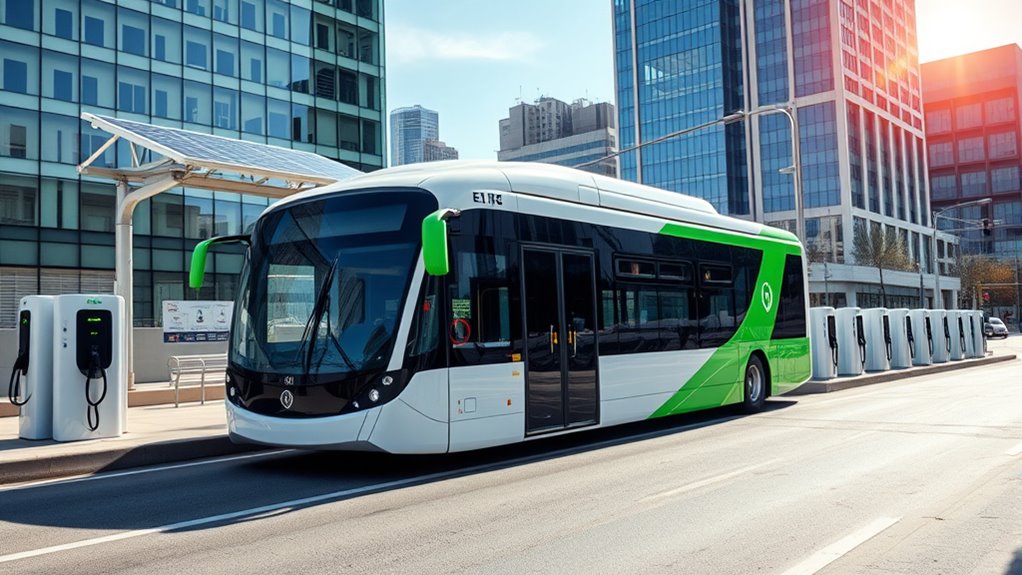New funding opportunities for electric bus fleets are expanding through federal programs like the Bipartisan Infrastructure Law, offering grants from agencies such as USDOT, DOE, and EPA. States and utilities also provide rebates and incentives to reduce costs for vehicle and infrastructure upgrades. Green banks and financing options further support fleet electrification. If you keep exploring, you’ll discover how these resources can help you plan and implement your electric bus projects effectively.
Key Takeaways
- Federal programs like the Bipartisan Infrastructure Law (BIL) provide grants for electric bus procurement and infrastructure development through agencies such as USDOT, DOE, and EPA.
- State and local incentives, including utility rebates and AQMD funds, reduce upfront costs for electric bus fleets and charging infrastructure.
- Utility companies offer rebates and technical assistance for installing charging stations and integrating renewable energy solutions.
- Green banks and financing programs provide loans and financial products to support large-scale fleet electrification projects.
- Non-profit organizations and online marketplaces offer additional resources, guidance, and funding opportunities for electric bus projects.

Are you looking to shift your fleet to electric buses but uncertain about funding options? The good news is, there are numerous sources available to help you finance this transition.
Federal programs play a significant role, especially through the Bipartisan Infrastructure Law (BIL), which allocates substantial funds via various agencies like USDOT, DOE, and EPA. These agencies offer grants and support for electric school buses and related infrastructure development. For example, the FTA provides grants specifically aimed at replacing or rehabilitating buses, including those powered by new propulsion technologies like electric motors. These grants are often awarded through competitive proposals, so putting together a compelling application can increase your chances of securing funding.
Federal programs under the Bipartisan Infrastructure Law provide grants for electric buses and infrastructure development.
State and local governments also provide valuable incentives to encourage electric bus adoption. In California, for instance, programs run by utilities such as SMUD and Southern California Edison (SCE) offer rebates for vehicles and charging infrastructure. The local Air Quality Management Districts (AQMD) often have dedicated funds for school bus electrification, helping cover the costs of switching from traditional diesel models. These incentives can considerably reduce your upfront expenses, making it easier to plan your fleet upgrade. Additionally, state-level incentive programs can further enhance funding opportunities for your projects.
Utilities like SDG&E and PG&E don’t just offer rebates for purchasing electric buses; they also provide advisory services to guide your fleet electrification journey and offer rebates for installing charging infrastructure, which can be a major cost component. Furthermore, the integration of renewable energy sources with charging stations can maximize environmental benefits and reduce operational costs over time. Engaging with these utilities can also provide access to technical expertise that is crucial for successful implementation.
Beyond government grants and utility incentives, green banks serve as an excellent financing resource. They provide loans or other financial products designed specifically for sustainable infrastructure projects, including electric bus fleets. These options can make large-scale electrification projects more manageable by spreading out costs over time.
Additionally, Etsy Shops and online marketplaces can be useful for sourcing specialized equipment or parts needed for infrastructure upgrades or retrofitting existing buses, especially if you are seeking cost-effective solutions. Non-profit organizations also play a role, assisting transportation agencies in identifying and applying for funding opportunities. Their expertise can be invaluable, especially if you’re navigating complex application processes or seeking multiple funding streams.
Frequently Asked Questions
How Long Does the Application Process Typically Take?
You’re wondering how long the application process usually takes. Typically, it can span several months, depending on the program’s complexity and preparation time.
You’ll need to gather necessary documents, secure partnerships, and get approvals, which can extend the timeline.
Once you submit your application through the designated portal, it undergoes review, and you’ll be notified of the results.
Planning ahead guarantees you meet deadlines and maximize your chances of success.
Are There Specific Eligibility Criteria for Different Fleet Sizes?
You’ll find that eligibility criteria vary based on your fleet size. Small fleets may need to demonstrate local air quality impact, while medium fleets require detailed planning and a commitment to long-term shift.
Large fleets often face stricter financial and operational requirements. Whether your fleet is public or private, showing community benefits can boost your chances.
Make sure your infrastructure, operational plans, and funding contributions align with the specific size and type of your fleet.
Can Funding Be Used for Infrastructure Upgrades?
You ask if funding can be used for infrastructure upgrades. Yes, it can. Many grants support not only purchasing electric buses but also necessary infrastructure like charging stations.
These funds help you develop a thorough electric fleet, enhance service reliability, and reduce emissions. By leveraging available grants, you can upgrade your infrastructure, install charging facilities, and ensure your electric bus operations are efficient, sustainable, and compliant with environmental standards.
What Are the Reporting Requirements After Receiving Funds?
You need to understand that after receiving funds, you’ll be required to submit regular reports detailing your project’s progress and finances. These reports, often quarterly or annually, must be accurate, timely, and follow specific formats, sometimes including visual data like charts.
Use electronic platforms for submissions, and guarantee your team manages data properly. Meeting these requirements is essential to maintain your funding and demonstrate program success.
Are Private Companies Eligible for These Funding Opportunities?
Your curiosity about private companies and funding is the key to opening new opportunities. Yes, private companies can be eligible for many funding programs, especially if they meet specific criteria like business size, vehicle type, and location.
Programs like HVIP and private sector grants are open to you, especially if you’re committed to sustainability. Just make sure you follow application guidelines and demonstrate your environmental goals to qualify.
Conclusion
With new funding opportunities, you can transform bustling city streets into quiet, clean corridors of electric buses. Imagine the contrast: smoky, noise-filled roads replaced by silent, eco-friendly transit. These grants and incentives offer a chance to accelerate your fleet’s sustainability, highlighting a future where technology and environmental responsibility drive transportation forward. Seize the opportunity now to turn the chaos into calm, and make your community’s journey greener and cleaner.









